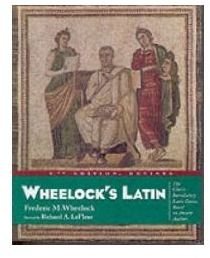A Review of Wheelock’s Latin 6th Edition by Frederic M. Wheelock
For several decades, university classics departments have seen crests and lulls in the popularity of Latin. What was once the standard language of science and politics throughout Europe has deteriorated to an anachronistic relic enjoyed by far fewer people than ever before.
However, Latin endures as a symbol of prestige and scholarship even though so few are able to carry out a conversation in the language. So revered is Latin that at least one university still carries out its commencement address in the language even though almost no one in the audience can understand the words being spoken.
Wheelock’s Latin represents one of the only ways to study the language save for an enormous expense in tuition paid to a classics department in a university. As a tool for learning the language, Wheelock’s Latin is complete, concise, and accessible with only a few caveats to consider before using the program to embark on the Latin acquisition adventure.
Completeness (5 out of 5)
Wheelock’s Latin was and is an attempt to encapsulate an entire Latin program into one complete package. Consequently, the program’s completeness is more than adequate to keep an elementary student busy for many months or even years.
Wheelock’s Latin uses actual ancient texts to teach the intricacies of the languages. Of course, at the beginning of the program, much of the ancient texts have been simplified to fit within the pedagogical goals of the individual chapters. Still, the forty chapters capture enough of the language such that mastery of program could grant one the right to consider oneself an expert in elementary Latin.
Self-Learning (3 out of 5)
The question many people have about Wheelock’s Latin is whether the program is suitable for self-learners. Can you learn elementary Latin from Wheelock’s Latin program? Generally, I will answer this question with a yes with a few words of advice to anyone wishing to pursue Wheelock’s Latin as an alternative to university study.
First, the program does make some assumptions about the knowledge of the self-learner. For example, if you don’t know the different between the present perfect tense and the past perfect tense or you don’t understand the concept of conjugating a verb, you will likely struggle with this program. A certain mastery of one’s own language will not only aid in the use of Wheelock’s Latin, it is occasionally a necessity. These issues are amplified because the self-learner has no teacher to fall back on to fill in the learning gaps.
Second, the program can be quite stoic in its introduction of key chapter concepts. Sure there is a glib joke thrown in here and there but the core material is presented with little feeling or human quality attached. For those wishing to be entertained while they learn, Wheelock will disappoint. Given the amount of material to be covered, one can understand that the book must be free from extraneous content so that the program does not need to be split into multiple volumes.
Ease of Use (4 out of 5)
Moving from chapter to chapter, the self-learner will find that the content flows nicely. Concepts are explained, examples are given, and then students may apply their knowledge in the translations and exercises found at the end of each chapter. Unfortunately, no answer key is given to check the student’s work but answers to the end-of-chapter exercises can be found on the web with a quick online search.
If there is one truth about Latin it is that this is a language of exceptions. It seems that with every rule, there are at least several exceptions the Latin student must memorize. Wheelock’s Latin does a nice job of pointing out these exceptions and reiterating them in the exercises and translations. This is where the strength of the program shines; the student is never asked to take an exception to a rule on blind faith.
Prose (3 out of 5)
Admittedly, Wheelock’s Latin is not a fascinating read with its brief and often stoic introductions to new concepts and grammar. The inquisitive student may be left wondering why the ablative of manner uses a preposition while the ablative of means does not. Similarly, the student is taught that the gerund has no nominative form because the Romans preferred to use the infinitive form of a verb to indicate the subject of the sentence. These types of anomalies are not discussed at length in Wheelock’s Latin but to the credit of the authors, this is an elementary program so not everything can be addressed. Still, there are times when the student is left wondering why time is spent on one topic while others are glanced over.
Overall Impressions of Wheelock’s Latin
Overall, Wheelock’s Latin program is more than appropriate for the self-leaner. Its style and comprehensiveness leave no elementary Latin stone unturned. At the completion of this program, students should have as much knowledge on the subject of the Latin language as a three-course high school or college program. Truly, it is a complete and competent attempt to bring the Latin language to the masses without the expense of tuition and materials of a university Latin program.
This article has been placed in our archives.
